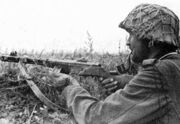The PPSh-41 was a selective fire SMG that was used by the Soviet Union throughout World War II. It was the main Soviet Sub-Machine Gun of the War. While it's official name was the PPSh-41, soldiers often called it the Pee-pee-Shaw, though the reasoning for this is unknown.
Description[]
It had a length of 84.3 cm and it fired the 7.62x25mm Tokarev Cartridge. The PPSh-41 could either have a seventy-one round drum or a thirty-five round box magazine. However, the drum magazine would sometimes mis-feed after the first sixty-five rounds were fired, and was extremely difficult to load, as it was almost assembled around the cartridges.
The empty weight of the PPSh-41 was 3.64 kilograms. The rate of fire was 900 rounds per minute and the muzzle velocity was 487 m/s. Depending on the production status, there could be flip-up rear iron sights or adjustable rear iron sights.[1] Right in front of the trigger was the switch between having semi-automatic and fully automatic. To reduce the muzzle climb caused by the recoil, there was a compensator which was built into the muzzle jacket or exterior area of the barrel. The PPSh-41 had no variants besides the small differences such as the iron sights between early production models and later modified models.
German Use[]

A captured PPSh-41 being used by a German soldier
PPSh-41s sometimes fell into German hands, and when they did they were refitted to the 9mm Parabellum round. The non-refitted versions, which could also fire the 7.63mm Mauser pistol round if Soviet 7.62mm ammunition was in short supply,[2] were designated MP717(r) and the refitted versions were designated MP41(r).[3] These modified PPSh-41s even use magazines from the MP 40.
History[]
The PPSh-41 was created by Georgy Shpagin in 1941 because of the need for a submachine gun with a high rate of fire, being able to be produced cheaply, and a fairly simplistic design. Mosin rifles were often used as the source for 7.62mm barrels, as the rest of the gun could be produced in any tin shop. The PPSh-41 was used in almost every World War II battle on the Eastern Front since its inception in 1941. The fact that it could be produced cheaply and also produced on such a massive scale allowed it to be used to turn Soviet conscripts into a deadly force. It could be used to clear rooms or to fight on an open battlefield, where its rate of fire and fairly long-ranged cartridge made sure it would hit something.
Towards the middle of World War II, the PPS-43 began to reach massive production and it was used mainly for operating in tight spaces where the PPSh-41 simply couldn't; it was also lighter and even cheaper. Even though the PPS-43 was produced in massive numbers, the PPSh-41 still remained one of the most common infantry weapons. It also became the most iconic Soviet weapon of World War II, but it was replaced soon after World War II by the AK and SKS rifles, and later, the Czech Skorpion vz. 61 submachine gun (except that the Soviets abandoned SMGs with the introduction of assault rifles).[4] However, by the time World War II ended, over 6 million had been produced.
References[]
| |||||||||||||||||||||||
